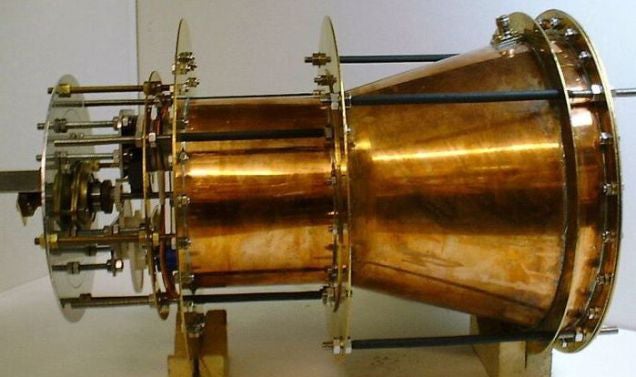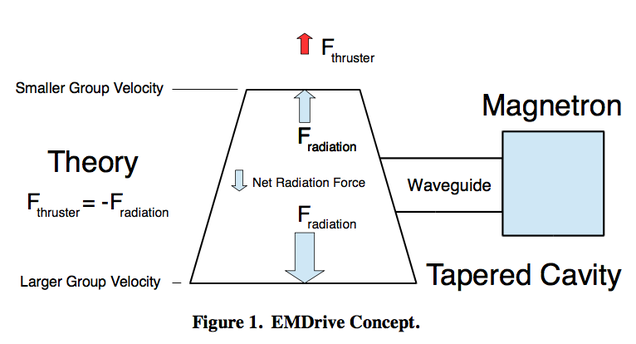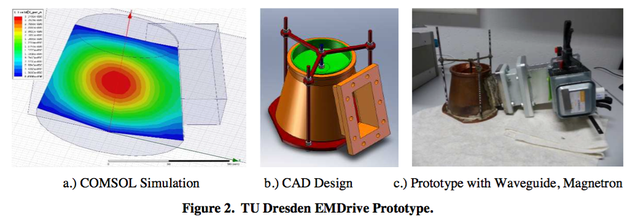
Posted on 07/29/2015 10:27:45 AM PDT by Red Badger

Two German researchers claim they have produced measurable amounts of thrust using a copy of NASA’s controversial EMDrive. It’s a result that has many people talking, but don’t plan your trip to the to the Alpha Centauri system just yet—the experts we spoke with are all highly skeptical of the study and its findings.
As reported in Hacked, the details of the new study are being presented this week by Martin Tajmar, a professor and chair for Space Systems at the Dresden University of Technology, and co-author G. Fiedler, at the American Institute for Aeronautics and Astronautics’ Propulsion and Energy Forum in Orlando. A copy of the study, which has yet to undergo peer review, has been made available prior to the conference: “Direct Thrust Measurements of an EMDrive and Evaluation of Possible Side-Effects.” The Impossible Engine
Unlike conventional thrusters which need propellant, the electromagnetic drive, or EMDrive, works by converting electric power to thrust by bouncing microwaves within a closed container. But with no expulsion of propellant, there’s nothing to balance the engine’s momentum during acceleration; on paper, this device appears to violate conventional physics and laws of conservation of momentum. Hence the controversy. Critics of the EMDrive, of which there are many, say it’s all poppycock.

Earlier this year, scientists at the NASA Eagleworks advanced concepts lab performed an experiment in which a copy of the engine appeared to work within a vacuum—an intriguing result that rekindled debate, while also demonstrating the engine’s potential to work in space. As a recent post by David Hambling in Wired points out, the EMDrive could reach Pluto in just 18 months, as opposed to the 9-year trip taken by New Horizons.
The recent experiment by Tajmar and Fiedler was an effort to reproduce the Eagleworks results, also within vacuum conditions.

“Our measurements reveal thrusts as expected from previous claims after carefully studying thermal and electromagnetic interferences,” write the authors in their study.
Specifically, the researchers observed apparent thrusts of ~20 micro-Newtons at a low Q factor of <50. (In a resonator cavity such as the proposed EMDrive, Q factor gives information about the radiative leakage, linewidth, and other physical quantities of interest)
“Our test campaign can not confirm or refute the claims of the EMDrive but intends to independently assess possible side-effects in the measurements methods used so far,” conclude the authors. “Nevertheless, we do observe thrusts close to the actual predictions after eliminating many possible error sources that should warrant further investigation into the phenomena.”
Looking ahead, the researchers say they’re going to conduct the experiment with improved magnetic shielding, perform further vacuum tests, and use “improved EMDrive models with higher Q factors and electronics that allow tuning for optimal operations.” Causes for Concern
While the latest results surrounding the EmDrive are certainly interesting, there are many reasons to remain skeptical.
“The microwave cavity thruster as set-up by Tajmar continues to violate momentum conservation and thus does not work as advertised,” says Eric W. Davis, a Senior Research Physicist at the Institute for Advanced Studies at Austin. “Why he doesn’t simply capitulate to that very obvious well-known issue in this particular application of electromagnetic physics is unknown to me. Maybe he is playing the role of the ‘supportive skeptic’ that wants to test this incredible outlandish EM propulsion claim for himself to see what it does.”
Davis says the German researchers have fallen into an experimental pitfall by claiming to have identified all “obvious” sources of systematic artifacts that could produce the tens of micro-Newton thrust signals that they measured. He accuses them of playing “word games” through their claims that there are other possible sources of systematic artifacts that remain untested, while at the same time insisting that they measured the same level of thrust reported in previous separate experiments by Sawyer, NASA’s Harold White (at Eagleworks), and a team of Chinese scientists.
Davis noticed some problems in the experiment as well.
“I noted in [the study’s] conclusion paragraphs that [Tajmar’s] apparatus was producing hundreds of micro-Newtons of thrust when it got very hot and that his measuring instrumentation is not very accurate when the apparatus becomes hot,” Davis told io9. “He also stated that he was still recording thrust signals even after the electrical power was turned off which is a huge key clue that his thrust measurements are all systematic artifact false positive thrust signals.”
“The experiment is quite detailed but no theoretical account for momentum violation is given by him, which will cause peer reviews and technical journal editors to reject his paper should it be submitted to any of the peer-review physics and aerospace journals,” Davis added.
NASA aerospace engineer Marc Millis tells io9 something similar. The experiment, Millis explains, seemed to show thrust lingering even after the power was off, which would be indicative of a thermal effect.
What’s more, when looking at previous EMDrive experiments, Davis noticed that the alleged thrust was generated slowly, and not instantaneously, when the electrical power was switched on.
“This is a direct indication of a thermal effect in reverse (heating versus cooling), which produces a clear false positive thrust signal,” says Davis. “Tajmar has to account for and reconcile this fact as well in his data analysis which he apparently did not discuss in his paper. This would be another nail in the coffin against the existence of any real definite momentum violating thrust produced in the microwave cavity.” Hype Engine
Davis points out that the researchers are not declaring any result that would definitively and positively substantiate previous experiments, and adds that he has little faith in these sorts of projects producing meaningful engines for future spacecraft. What’s more, he says, “my professional colleagues who all work in the space propulsion engineering business at the major aerospace corporations are not at all interested in any new electric space propulsion inventions or claims that can only produce thrust on the order of micro-Newtons (via devices that require high voltages and high electric currents and high E & M field strengths) because that magnitude of propulsive thrust is not applicable to any meaningful space mission propulsion needs.”
CalTech physicist Sean Carroll, who we’ve spoken to previously about the feasibility of an EMDrive, echoes Davis’ sentiments.
“My insight is that the EMDrive is complete crap and a waste of time,” Carroll tells io9. “Right there in the abstract this paper says, ‘Our test campaign can not confirm or refute the claims of the EMDrive’, so I’m not sure what the news is. I’m going to spend my time thinking about ideas that don’t violate conservation of momentum.”
Note: An earlier version of this article incorrectly described Q factor as an electric charge. Rather it’s a dimensionless quantity related to resonators. Specifically, in a resonator cavity such as the proposed EMDrive, Q factor provides information about the radiative leakage, linewidth, and other physical quantities of interest.
Read the entire study at Aerospace Research Central: “Direct Thrust Measurements of an EMDrive and Evaluation of Possible Side-Effects”. Note: This is not a peer reviewed journal.
Yeah, if it really works I don’t think the mechanism will be related to transfer of inertia, because that all seems to cancel itself out in this kind of closed system.
Whether it turns out to be quantum or not, I don’t know, but if this is real, it can’t just be the particles slamming into the device and pushing it that causes thrust.
“an initial production run is expected soon”
We’ve been hearing it’s coming “soon” for several years now though.
yeah but where are you gonna find one of those these days? ... you can't cross your own time-line to go back to the 50's and get one
Correct, the acceleration "force" of a piece of paper sitting on a desk would move a ship through space at incredible speeds
Leonard Rossiter’s interroceter?
Now though, the primary inventor — Rossi — is working under the thumb of the North Carolina investment group. If the first production models arrive, say, two years from now, it will have been six years from Rossi’s initial demonstration to the first sale — which, coincidentally, is also the time it took the Wright brothers to go from their first flight at Kittyhawk to sale of their first model Flyer to the US Army.
It can be more than exhaust velocity. It it depends on 1) starting the mass of the vehicle + propellant, 2)the amount of propellant consumed when the thrust is complete, and 3) the exhaust velocity.
With modern chemical propulsion, a single stage burning its entire load of propellant reaches around twice the velocity of the exhaust. With staging, a payload can reach several times the exhaust velocities of the various rocket stages.
If Rossi actually delivers something in 2 years, I think I’d die of shock.
If you look at current ion thruster technology you’ll find they produce anywhere from 20 to 250 milli-Newtons of thrust which is a bit higher than 20 micro-Newtons with efficiencies anywhere from 60 to 80 percent.
https://en.wikipedia.org/wiki/Ion_thruster
Cool, thanks for the explanation.
Doesn’t take much force in space to move something.....................
Hmmm...hadn’t factored in the decreasing weight of the vehicle as fuel is consumbed. Thanks for the insight.
Yeah, that is a factor that makes multi-stage rockets more efficient, because they aren’t just burning the fuel, but also dropping the empty tanks off regularly.
Also, there is a diminishing return to take into account, for every ounce of fuel you add to the vehicle, you can get more acceleration, but it will also take more acceleration to get it into orbit. After a certain point, making the rocket bigger will just make it less efficient.
...Leonard Rossiter’s Interossiter?...
Actually, it belonged to two interesting white haired visitors with oddly shaped heads, one of who’s name is Exeter.
This Island Earth but I couldn’t resist tossing Reggie Perrin in.
In many ways, Andrea Rossi seems to fit that profile. Mercurial and flamboyant, he is naturally prone to veer between garrulous over-promising and the secretiveness and suspicion common to inventors. The Italian science establishment did not believe Rossi so much as they believed his late partner, Sergio Focardi, a respected physicist and professor who had long pursued cold fusion and had published a peer-reviewed paper on the subject.
Focardi's passing deprived Rossi of the restraint and judgment of a senior partner. Fortunately, that role now seems to be filled by the North Carolina investment group who purchased the rights to Rossi's E-Cat. As securities and anti-fraud laws virtually require, Rossi apparently has to get any his statements pre-approved by counsel. Backed by deep pockets, technical help, and canny businessmen, Rossi now seems to be the leading contender to bring a practical cold fusion device to market.
Disclaimer: Opinions posted on Free Republic are those of the individual posters and do not necessarily represent the opinion of Free Republic or its management. All materials posted herein are protected by copyright law and the exemption for fair use of copyrighted works.